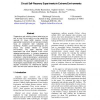Free Online Productivity Tools
i2Speak
i2Symbol
i2OCR
iTex2Img
iWeb2Print
iWeb2Shot
i2Type
iPdf2Split
iPdf2Merge
i2Bopomofo
i2Arabic
i2Style
i2Image
i2PDF
iLatex2Rtf
Sci2ools
EH
2004
IEEE
2004
IEEE
Circuit Self-Recovery Experiments in Extreme Environments
Temperature and radiation tolerant electronics, as well as long life survivability are key capabilities required for future NASA missions. Current approaches to electronics for extreme environments focus on component level robustness and hardening. However, current technology can only ensure very limited lifetime in extreme environments. This paper describes novel experiments that allow adaptive in-situ circuit redesign/reconfiguration in extreme temperature and radiation environments. This technology would complement material/device/layout advancements and increase the mission capability to survive harsh environments. The approach is demonstrated on a mixed-signal programmable chip (FPTA-2), which recovers functionality for temperatures reaching 280o C and with total radiation dose up to 175kRad.
EH 2004 | Extreme Environments | Hardware | Radiation Environments | Radiation Tolerant Electronics |
| Added | 20 Aug 2010 |
| Updated | 20 Aug 2010 |
| Type | Conference |
| Year | 2004 |
| Where | EH |
| Authors | Adrian Stoica, Didier Keymeulen, Tughrul Arslan, Vu Duong, Ricardo Salem Zebulum, Ian Ferguson, Xin Guo |
Comments (0)

